Eco-Conscious Products
- Basic approach
- Structure
- Targets and results
- Initiatives related to eco-conscious products
- Initiatives related to LCA calculations
Basic approach
Under the "TOYOBO Group Fundamental Policy on the Global Environment," the Toyobo group promotes to reduce and improve the impact on environment by developing new technologies. At every stage, from product development through to design, manufacture, sale, disposal, and collection, we are forecasting, evaluating, and reducing their impact on the environment, and working towards its protection.
Structure
Mechanism for certification of eco-conscious products
Since 1998, Toyobo Group has operated the Eco-Review System to evaluate the environmental impact and eco-friendliness of our products from an environmental conservation perspective.
Under this system, we assess our products and technologies according to proprietary criteria, based on evaluation items categorized as preventing climate change, reduction of chemical substance use, resource conservation, waste reduction, and biodiversity and other environmental factors. The assessments take a life cycle perspective, covering every stage from raw material procurement through to disposal.
Products that receive an evaluation above a certain standard are certified under our ECO-PARTNER SYSTEM®. Eco Reviews are conducted at every stage from research and development through to commercialization. For themes deemed to require improvement during the R&D stage, an additional Eco Review is carried out before commercialization to ensure enhancements are made. This process enables us to continuously improve our products and technologies during development, further reducing their environmental impact and enhancing their contribution to environmental conservation.
Eco-Review Evaluation Items

Review and Certification Process
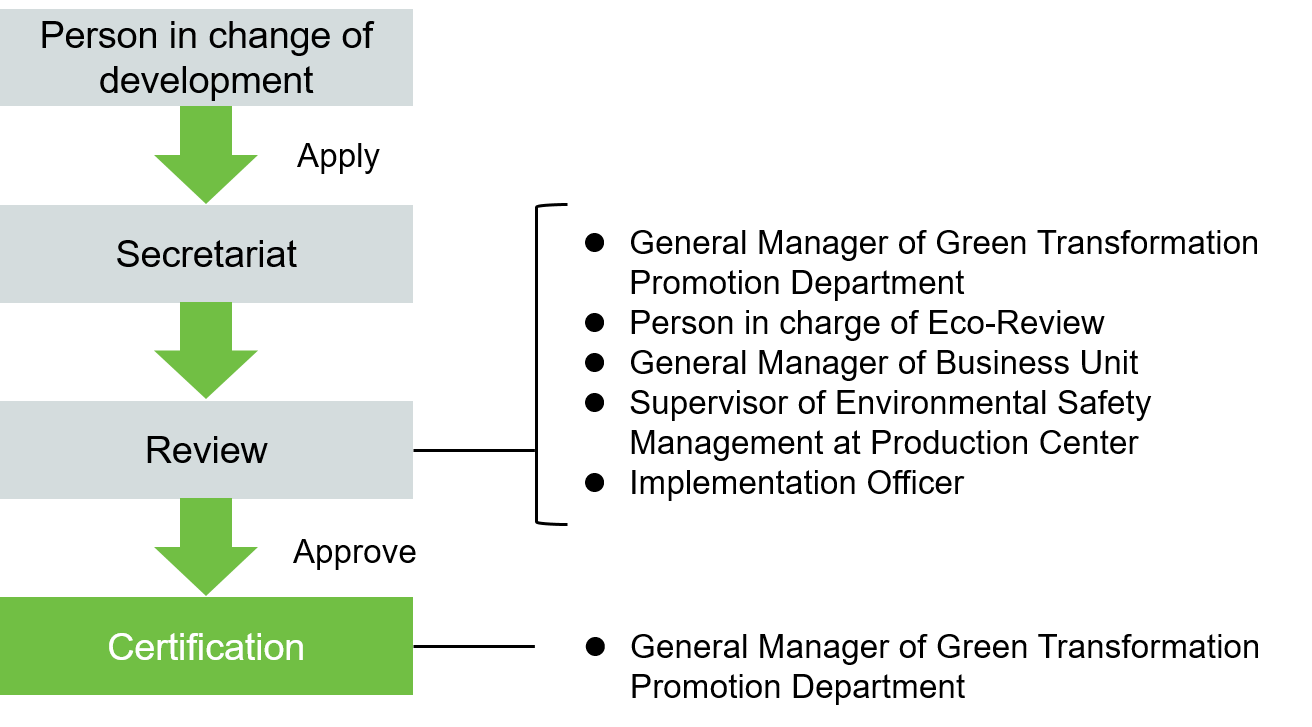
ECO-PARTNER SYSTEM®
Products that meet or exceed a certain standard in the Eco-Review System are designated as ECO-PARTNER SYSTEM® products, contributing to reduced environmental impact and enhanced environmental performance.
The evaluation criteria for the ECO-PARTNER SYSTEM® are divided into five categories, including “resource conservation.” A product's life cycle—from raw materials through to disposal—is divided into six stages, and the environmental impact at each stage is evaluated as part of the certification process.
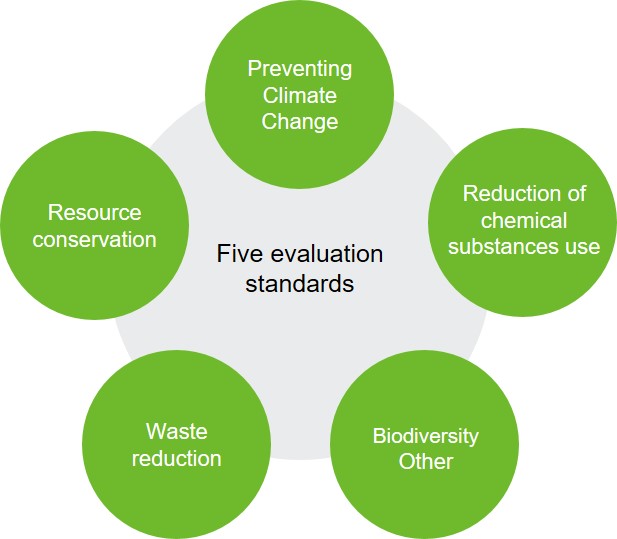

Targets and results
We aim to increase the ratio of sales of ECO-PARTNER SYSTEM® products to 40% of total sales by fiscal 2031 and 60% by fiscal 2051.
| Initiatives | Targets (FY2031) | Results (FY2025) |
|---|---|---|
| Sales ratio held by ECO-PARTNER SYSTEM® products (TOYOBO,TMC) | 40% | 30.7% |
Sales by Evaluation Standard of ECO-PARTNER SYSTEM® Products(FY2025)
| Five evaluation standards | ||||
|---|---|---|---|---|
| Preventing climate change | ¥45.2 billion | |||
| Resource conservation | ¥32.5 billion | |||
| Waste reduction | ¥49.1 billion | |||
| Reduction of chemical substance use | ¥51.4 billion | |||
| Biodiversity and other environmental factors | ¥32.5 billion | |||
| Note: Net sales in the figure include duplicates because they are determined based on multiple criteria. | ||||
Initiative
ECO-PARTNER SYSTEM® Products
Below are examples of products certified under our ECO-PARTNER SYSTEM®, which contribute to mitigating climate change, reduction of chemical substance use, resource conservation, waste reduction, and biodiversity and other environmental factors.
Initiatives for LCA calculation
We calculate LCA as appropriate by introducing MiLCA, a software for computing LCA.
In addition, LCA calculations are based on the following standards.
LCA Principles and Framework: ISO 14040
LCA Requirements and Guidelines: ISO 14044,
GHG Protocol: Product Life Cycle Accounting and Reporting Standard
Calculation of reduction contribution
By comparing the carbon-life cycle assessment (cLCA) of a baseline product with that of high environmental performance product, it is possible to visualize the contribution to CO2 reduction achieved by replacing the baseline product with the higher-performance alternative. We began calculating the amount of contribution to reduction in fiscal 2023 for reverse osmosis (RO) membranes and VOC (volatile organic compound) recovery equipment. In calculating the amount of reduction contribution, we have established our own guidelines based on the “Guidelines for Assessing the Contribution of Products to Avoided Greenhouse Gas Emissions” issued by the institute of Life Cycle Assessment, Japan. We also refer to the Ministry of Economy, Trade and Industry's “Guidelines for Quantifying GHG emission reductions of goods or services through Global Value Chain ” and other guidelines. We will continue to expand the number of products subject to calculation, reduce CO2 emissions generated when our customers use our products, and contribute to the mitigation of climate change throughout our supply chain.
Case ① VOC recovery equipment
Toyobo's VOC recovery equipment is used around the world to control emissions of volatile organic compounds (VOC), which are feared to affect the atmosphere and human health. Our VOC recovery equipment incorporates "K-FILTER®", an unique activated carbon fiber, and it is used in various industries to recover dichloromethane used in the lithium battery separator manufacturing process and to control emissions and recover ethyl acetate (which is used in dry lamination and adhesive processes), toluene, and IPA etc.
Assuming that the steam desorption VOC recovery equipment sold by our group in fiscal 2023 operates for 15 years, the amount of VOC (methylene chloride, etc.) recovered will be approximately 6 million tonnes*. In addition, "K Filter®" makes it possible to recover high-quality solvents and save energy because it is a high-performance adsorbent that has a faster adsorption rate than granular activated carbon and contains fewer impurities. Our VOC recovery equipment can reduce carbon dioxide emissions by approximately 50 to 70% compared to conventional VOC combustion equipment when treating combustible VOC such as ethyl acetate and toluene (according to research by Toyobo).
Furthermore, our group also sells the nitrogen desorption type "K Filter®" VOC recovery equipment, which is even more energy-saving. Since nitrogen is purified and reused using a unique circulation method, it can be processed at low running costs, and it is also possible to recover and reuse water-soluble solvents and significantly reduce wastewater. Compared to conventional steam desorption methods, CO2 emissions during treatment are expected to be reduced by approximately 50 to 80%*.
Going forward, to contribute toward the realization of the decarbonized society, we will expand applications of our VOC recovery equipment and sales promotion of our nitrogen desorption type VOC recovery equipment, which is more energy efficient.
- Our group calculations
- VOC recovery apparatus (steam desorption type) K-FILTER®
- VOC recovery apparatus (nitrogen desorption type) K-FILTER®
VOC treatment equipment's CO2 emissions compare (e.g.)
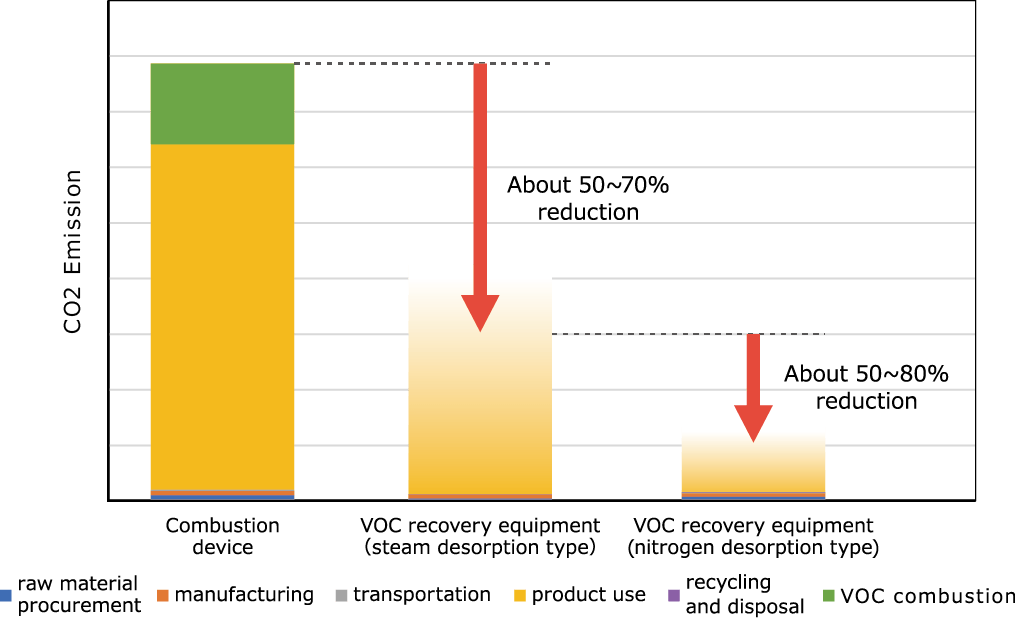
- Calculation Conditions: VOC Processing Capacity is calculated by setting the same conditions for the combustion device and the recovery device our group-wide calculation.

VOC recovery equipment
Case ② RO Membrane for seawater desalination
Globally, water shortages are becoming an increasingly serious problem. We provide hollow fiber reverse osmosis (RO) membrane, which enables desalination with low energy consumption, to countries throughout the world, especially in regions where there is inadequate access to fresh water. By comparison with the conventional multi-stage flush (MSF) method, Toyobo’s method using RO membrane makes it possible to achieve a substantial reduction in CO2 emissions.
Toyobo's RO membrane is made mainly from biomass material, and it has a number of unique features, including long product lifespan of eight years or more, and being able to produce high-purity fresh water. Additionally, the superior chlorine resistance of the membrane material keeps maintenance costs down.
Assuming that the RO membrane elements sold by our group is used for eight years, freshwater production would be approximately 900million m3*, and avoided emissions (reducing CO2 emissions) will be approximately 9 million tonnes*.
Going forward, we will be expanding production of RO membrane so that it can be used to meet the daily water needs of around 10 million people through seawater desalination (this is the target for Sustainable Vision 2030).
- Our group estimate.
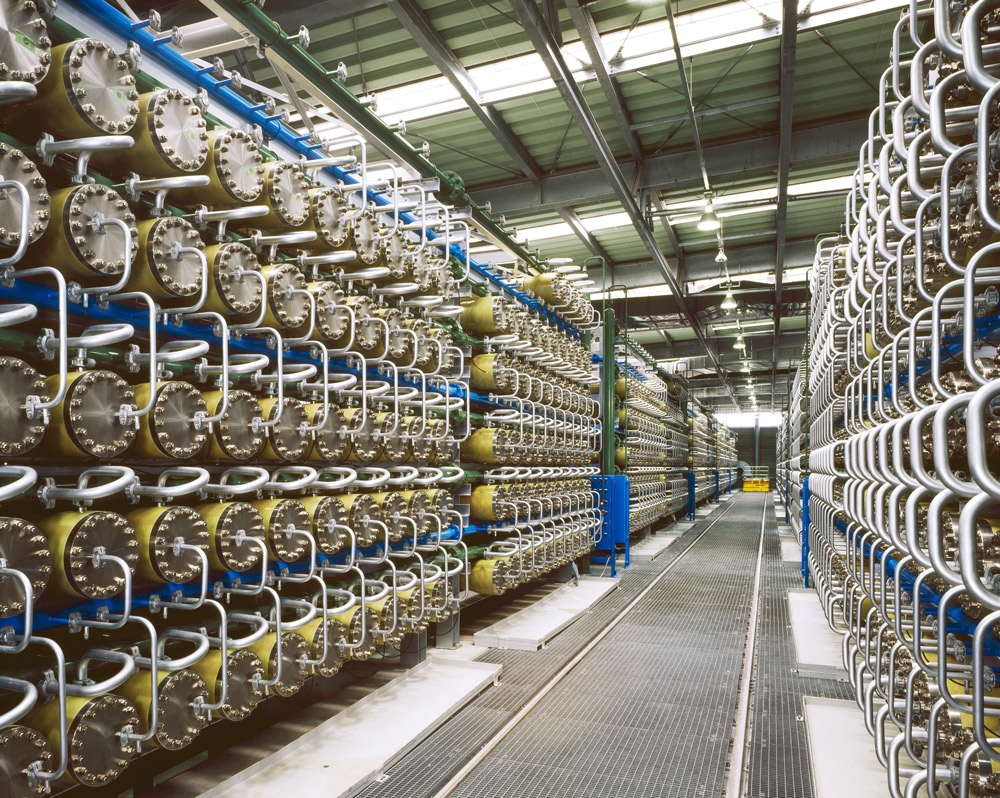
Seawater desalination plants
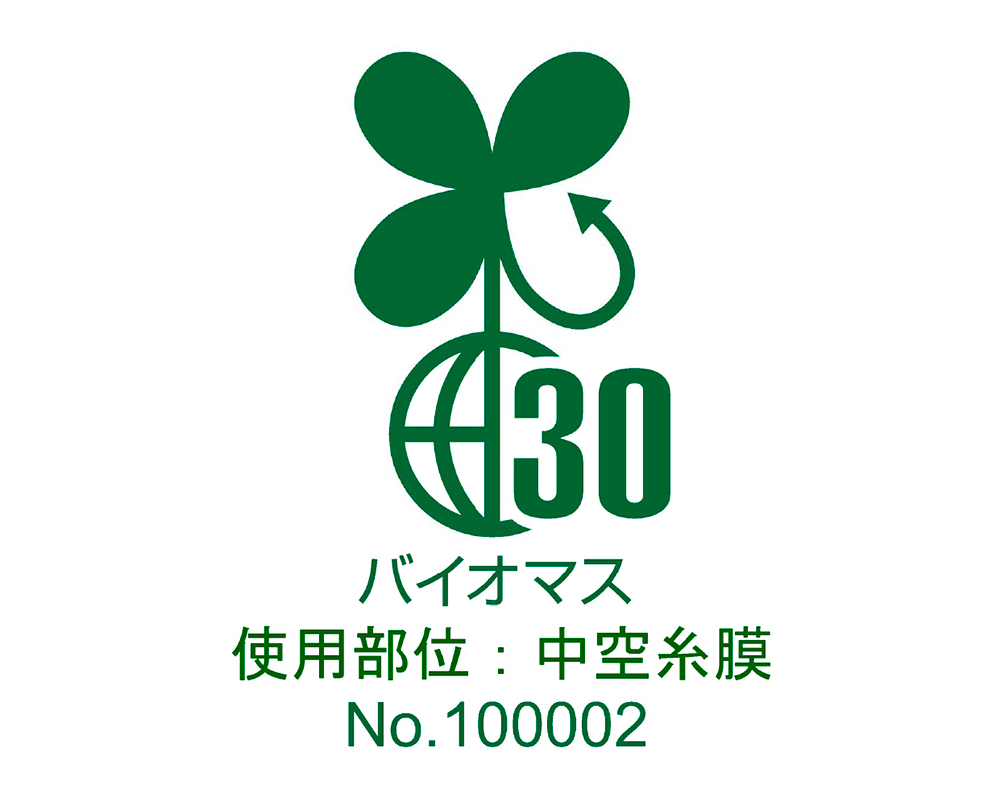
Biomass Mark for our hollow fiber membrane in HOLLOSEP®.






